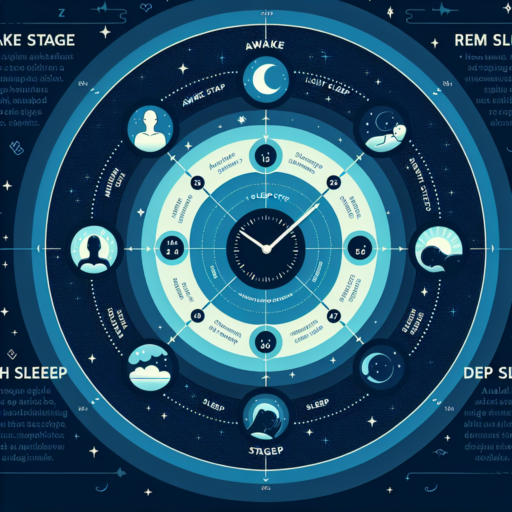What are the 4 stages of the sleep cycle?
Understanding the 4 stages of the sleep cycle is crucial to comprehending how our bodies rest and rejuvenate every night. These stages are part of a larger process that alternates between Non-Rapid Eye Movement (NREM) sleep and Rapid Eye Movement (REM) sleep, creating a complex pattern vital for our physical and mental health.
Stage 1: NREM – The Onset of Sleep
The first stage serves as the transition period from wakefulness into sleep. During this brief period, which typically lasts for several minutes, our body starts to relax, our heartbeat, breathing, and eye movements slow down, and our muscles begin to loosen. This stage is characterized by light sleep where one can be easily awakened.
Stage 2: NREM – Light Sleep
Progressing into the night, we enter the second stage, which still falls under NREM sleep but is slightly deeper than the first. Here, our body continues its downward trend into relaxation with further slowing of the heartbeat and cooling of the body temperature. This stage acts as a preparatory phase for the deep sleep that follows and constitutes the largest part of the sleep cycle.
Stage 3: NREM – Deep Sleep
In the third stage, our body reaches the deep sleep phase. It is during this stage that the body undergoes the most significant amount of repair and regeneration. Our heartbeat and breathing rate reach their lowest levels, and muscles are completely relaxed. This stage is critical for physical restoration, energy replenishment, and certain aspects of memory consolidation and learning.
What is the 5 stage of sleep?
The 5th stage of sleep, commonly referred to as REM (Rapid Eye Movement) sleep, is a critical phase in our sleep cycle. Unlike the first four stages, which are considered non-REM sleep, REM sleep is characterized by rapid movement of the eyes, increased brain activity, and vivid dreams. This stage usually begins about 90 minutes after falling asleep and recurs several times throughout the night, with each period lasting longer than the last.
During REM sleep, the body undergoes several significant changes. Muscles become temporarily paralyzed, preventing the sleeper from acting out their dreams. Heart rate and blood pressure rise, and breathing can become fast and irregular. It’s in this stage that the brain is almost as active as it is when you are awake. This heightened brain activity plays a crucial role in the consolidation of memories and learning. Cognitive processes are strengthened during REM sleep, making it essential for problem-solving skills and creativity.
Interestingly, the duration and quality of REM sleep can be influenced by various factors, including age, lifestyle choices, and overall health. Newborns spend almost 50% of their sleep in the REM stage, a figure that dramatically decreases with age. Adults, on the other hand, spend roughly 20% of their sleep in this restorative phase. Ensuring a healthy balance of all sleep stages is key to achieving restorative sleep and maintaining optimal health and well-being.
No se han encontrado productos.
How long should you be in each sleep stage?
Understanding the duration of each sleep stage is crucial for achieving restorative sleep, which is essential for overall health and well-being. The sleep cycle is divided into four stages, each playing a unique role in the sleep process.
The NREM Stages
The first three stages of sleep fall under Non-Rapid Eye Movement (NREM). Stage 1, a light sleep, typically lasts 1 to 5 minutes, serving as a transition phase. During this stage, it’s easy to be woken up. Stage 2, a slightly deeper sleep, accounts for approximately 45-55% of total sleep time in adults, equating to about 25-30 minutes per cycle. Finally, Stage 3, also known as deep sleep or slow-wave sleep, is crucial for physical recovery and growth. Adults spend 15-25% of their sleep in this stage, around 20-40 minutes per cycle.
The REM Stage
Following the NREM stages, the REM (Rapid Eye Movement) stage occurs. This is the dream stage of sleep and is crucial for cognitive functions such as memory and learning. In the first sleep cycle, REM lasts only a few minutes. However, as the night progresses, REM sleep durations increase, with the longest periods occurring in the final cycles of the night. On average, REM sleep should constitute about 20-25% of total sleep in adults, translating to roughly 90-120 minutes.
Recognizing the significance of each stage and the ideal duration spent in them can help individuals tailor their sleep habits for optimal health and functioning. Adjusting sleep environments and routines can facilitate the transition through each stage to ensure a restorative night’s rest.
Is REM the deepest sleep?
Understanding the complexity of sleep stages is crucial for deciphering the question, Is REM the deepest sleep? Sleep is divided into several cycles, each comprising different phases that play unique roles in mental and physical health. REM, or Rapid Eye Movement sleep, is one of these pivotal stages, renowned for its association with vivid dreaming.
Contrary to common belief, REM sleep is not the deepest stage of sleep. Instead, it is characterized by increased brain activity, faster breathing, and paralysis of limb muscles to prevent acting out dreams. The deepest phase of sleep is actually known as slow-wave sleep (SWS), or delta sleep, which falls under the non-REM category. During SWS, the body focuses on physical recovery and restoration, signaling a significant decrease in heart rate, breathing, and brain activity.
It’s essential to differentiate between REM and deep sleep stages to comprehend their distinct impacts on health and well-being. While REM sleep facilitates memory consolidation, learning, and emotional processing, deep non-REM sleep is critical for physical rejuvenation, hormone regulation, and immune system strengthening. Understanding these roles helps to appreciate the complexity and importance of each sleep stage.




